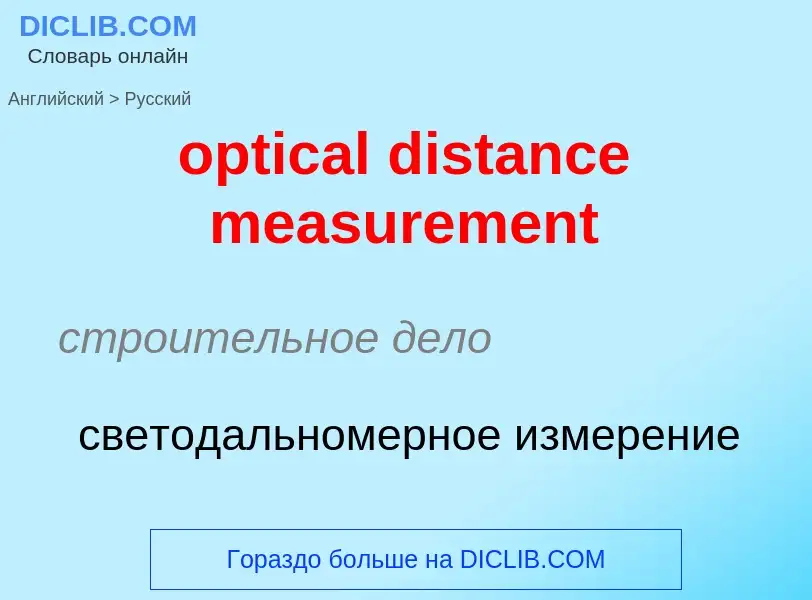Перевод и анализ слов искусственным интеллектом ChatGPT
На этой странице Вы можете получить подробный анализ слова или словосочетания, произведенный с помощью лучшей на сегодняшний день технологии искусственного интеллекта:
- как употребляется слово
- частота употребления
- используется оно чаще в устной или письменной речи
- варианты перевода слова
- примеры употребления (несколько фраз с переводом)
- этимология
optical distance measurement - перевод на русский
строительное дело
светодальномерное измерение
['dist(ə)ns]
общая лексика
расстояние
distance from end of snout to the insertion of the anal fin - антеанальное расстояние
distance from end of snout to the insertion of the dorsal fin - антедорсальное расстояние
flight distance
generalized distance
individual distance
patristic distance
дистанция
дальность
путь прохождения
протяжённость
отдалённость
временной промежуток
период
строительное дело
расстояние, дистанция
нефтегазовая промышленность
интервал
отрезок
существительное
['dist(ə)ns]
общая лексика
расстояние
большое расстояние
отдалённость
отдаление
даль
дистанция огромного размера
несходство
различие
степень отдалённости кровного родства
сдержанность
холодность
почтительное расстояние
промежуток
отрезок
период
перспектива (в живописи)
предфинишная черта (скачки)
дистанция (фехтование)
отдаленность
дальность
сдержанность, холодность (в обращении)
даль, перспектива (в живописи)
промежуток, период (времени)
спорт
дистанция
специальный термин
глубина
авиация
пробег
военное дело
интервал
техника
зазор
музыка
интервал между двумя нотами
Смотрите также
глагол
общая лексика
(from) помещать на (определённом) расстоянии
оставлять далеко позади
владеть перспективой (о художнике)
оставлять далеко позади себя
размещать на равном расстоянии
отдалять
Определение
Википедия
In aviation, distance measuring equipment (DME) is an ARNS system that measures the slant range distance or mostly just shortend to distance, between an aircraft and a ground station by timing the propagation delay of radio signals in the frequency band between 960 and 1215 megahertz (MHz). Radio-Line-Of-Sight (RLOS) between the aircraft interroagtor and the ground transponder is required. An interrogator (airborne) initiates an interrogation by transmitting a pulse pair of the selected pulse code, on the selected 'channel', to trigger a reply by a DME or TACAN ground based transponder. The channel number and identifier for the pulse code of a channel specifies the carrier frequency offset between the interroagtion and reply frequency and the pulse code (spacing between the pulses). After a fixed delay of 50 µs, the transponder transmitts a reply pulse pair on a frequency, that is offset by either +63 MHz or -63-MHz from the interrogation frequency.
DME systems are used worldwide, using standards set by the International Civil Aviation Organization (ICAO), RTCA, the European Union Aviation Safety Agency (EASA) and other bodies. Some countries require that aircraft operating under instrument flight rules (IFR) be equipped with a DME interrogator; in others, a DME interrogator is only required for conducting certain operations.
Both stand-alone DME or TACAN transponders, and DME- or TACAN-transponder that are frequency paired with either an ILS, VOR, DVOR (both operating in the ARNS band 108 to 118 MHz), and/or a MLS (operating between 5000 and 5090 MHz) are standardized by ICAO in . ILS and MLS provide azimuth course and glide path elevation for APP purposes, while (D)VOR provide the azimuth to/from the ground transmitter for RNAV.
The EIRP of todays operational DME vary between ~58 dBW and ~72 dBm, and between ~56 dBm and ~78 dBm for TACAN, depending on interconnection losses between the transponder output connector and antenna radiating elements values can be lower.
ICAO characterizes DME transmissions as ultra high frequency (UHF). The term L-band is also used.
The initial ICAO DME was first standardized in May.1950 in and utelized 10 paired interrogation-/reply-channels and 10 pulse codes. The ICAO standard is based on the US DOT CAA DME . TACAN was defined A few years later by the US DOD and defined in. The coexistance of two DME systems lead later to the fact that a number of sites had VOR, DME and TACAN colocated in the US. US congress declassified the TACAN specifications and proposed to ICAO to replace DME with DMET (T = TACAN based).
During the Process of standardization of TACAN in ICAO and ARINC , </ref>the bearing function was dropped and only slant ranging remained. At first only the 126 x-pulse-code channel were defined , but due to the fact that less than 100 DME channel could be used in order to protect SSR operating on 1030/1090 MHz an aditional 126 y-pulse-code channel were defined in .
While most references only use DME today, actually this references DME/N, DME/W and DME/P.
A DME developed in Australiawas invented by James "Gerry" Gerrand under the supervision of Edward George "Taffy" Bowen while employed as Chief of the Division of Radiophysics of the Commonwealth Scientific and Industrial Research Organisation (CSIRO). Another engineered version of the system was deployed by Amalgamated Wireless Australasia Limited in the early 1950s operating in the 200 MHz VHF band. This Australian domestic version was referred to by the Federal Department of Civil Aviation as DME(D) (or DME Domestic), and the later international version adopted by ICAO as DME(I).
DME is uses the same principle as the on based IFF Mode 1 and 2 SSR Mode A to Mode D ranging function, except the roles of the equipment in the aircraft and on the ground are reversed the interroagtor is located on the ground and the transponder in the aircraft, using a different set of technical paramater than SSR.



